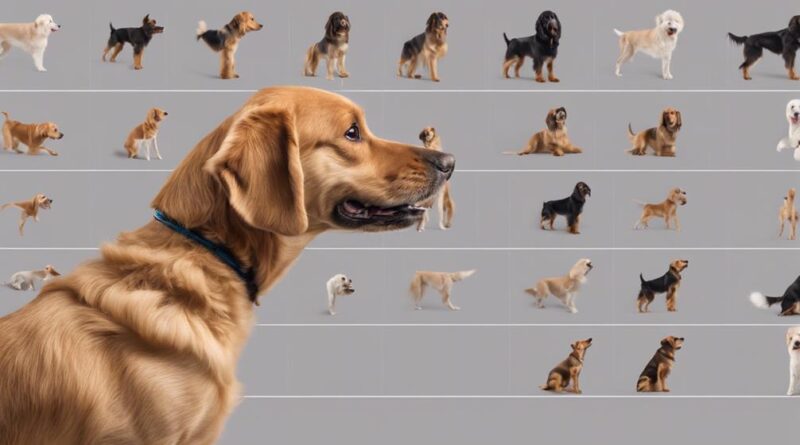Why Does Your Dog's Tail Wagging Speak Volumes?
When your furry companion's tail starts its rhythmic dance, it's like a silent conversation that you can decipher if you pay attention.
But have you ever wondered why your dog's tail wagging seems to convey so much more than just joy or excitement?
Understanding the nuances of tail wagging can provide you with a window into your dog's inner world, revealing a complex language that goes beyond what meets the eye.
Understanding Dog Tail Wagging
To understand your dog's tail wagging, observe the speed and direction of the wag as it communicates various emotions and intentions. Your furry friend's tail is a crucial part of their body language, serving as a window into their feelings.
Canine communication relies heavily on tail movements to convey messages to you and other dogs. When your dog wags their tail rapidly and vigorously, it often signifies excitement or happiness. On the other hand, a slow and low wag may indicate insecurity or submission.
Pay attention to the direction of the wag as well; a wag to the right suggests positive feelings, while a leftward wag can indicate anxiety or discomfort. By interpreting your dog's tail wagging along with other body language cues, you can better understand their emotional state and respond accordingly.
Types of Tail Wagging
When observing your dog's tail wagging, different types of movements can convey distinct messages about their emotions and intentions. Understanding these variations in tail wagging is crucial to interpreting your furry friend's body language and enhancing your communication with them.
- Broad, Loose Wag: A wide and loose tail wag often indicates a friendly and relaxed demeanor, showing that your dog is happy and comfortable.
- Stiff, Rapid Wag: A stiff and rapid wag can signal alertness or potential agitation, suggesting that your dog is on high alert or feeling tense.
- Low, Slow Wag: A slow and low tail wag may convey insecurity or submission, revealing that your dog is feeling unsure or submissive in a situation.
- High, Fast Wag: A high and fast tail wag is typically a sign of excitement or anticipation, demonstrating that your dog is enthusiastic or eager about something.
Tail Wagging and Emotions
Understanding how your dog's tail wagging correlates with their emotions provides valuable insight into their state of mind and enhances your bond with them.
Canine body language is a fascinating aspect of communication between dogs and their human companions. When your dog wags their tail in a relaxed manner with a wide sweep, it usually signifies happiness and a positive emotional state.
On the other hand, a stiff and rapid tail wag may indicate tension or potential aggression. Paying attention to these emotional cues can help you respond appropriately to your dog's needs and feelings.
Tail wagging can also be a sign of excitement, such as when you come home after being away for a while. By recognizing these emotional signals, you can strengthen your relationship with your furry friend and create a deeper understanding of their behavior.
Tail Wagging and Social Interaction
Engage with your dog's world by observing how their tail wagging influences social interactions with other dogs and humans. Canine communication is a complex interplay of various signals, with tail signals playing a crucial role in conveying emotions and intentions. Understanding these cues can help you decipher your furry friend's feelings and improve your bond.
Here are some key points to consider:
- Speed Matters: A fast wag usually indicates excitement or happiness, while a slow wag may signify uncertainty or wariness.
- Positioning: Pay attention to the height and direction of the tail. A high, stiff wag could signal dominance, while a low wag might indicate submission.
- Context is Key: The situation in which the tail wag occurs is essential. Tail wagging during play is different from wagging during a tense interaction.
- Consistency: Consistent patterns of tail wagging can reveal your dog's overall mood and temperament, helping you tailor your responses accordingly.
Tail Wagging and Aggression
To decipher if your dog's tail wagging indicates aggression, observe the speed, positioning, and context of the wag. When it comes to aggression signals, a fast and high tail wag often signifies dominance communication rather than a friendly gesture.
If your dog's tail is held high and stiff with quick, short wags, it could be a sign of potential aggression. In such cases, pay attention to other body language cues like raised fur, tense posture, or growling noises.
Context is key; if the tail wag accompanies protective behavior over toys, food, or territory, it might suggest a more aggressive stance. It's important to intervene appropriately by redirecting their focus or seeking professional training to address any aggressive tendencies.
Understanding your dog's tail wagging in the context of aggression signals can help prevent potential conflicts and ensure a harmonious relationship between you and your furry companion.
Tail Wagging and Anxiety
Deciphering your dog's tail wagging can also provide insights into potential anxiety signals they may be exhibiting. When your furry friend is feeling anxious, their tail movements can reveal a lot about their emotional state. Understanding these cues can help you provide the necessary support and comfort to alleviate their stress.
- Canine Stress: A dog experiencing stress may have a low wagging tail, tucked between their hind legs, indicating unease.
- Relief Signals: If your dog's tail wags slowly and gently, it might be seeking reassurance and comfort from you.
- Nervousness Indicators: A fast wagging tail accompanied by tense body language could signify nervousness or discomfort in your pet.
- Seeking Reassurance: Dogs may wag their tails in a more pronounced manner when they're anxious, seeking reassurance from their owners.
Tail Wagging and Happiness

Understanding how your dog's tail wagging reflects their happiness can deepen your bond and enhance your furry friend's well-being.
When your dog wags their tail, it's not just a random movement. It's one of the most recognizable signs of canine joy. Paying attention to your dog's tail wagging can provide valuable emotional cues.
A broad, vigorous wag usually indicates a happy and content pup. The speed of the wag can also convey different levels of excitement. A fast wagging tail may suggest a higher level of happiness compared to a slow wag.
Additionally, the position of the tail while wagging is crucial. A tail held high while wagging often signifies confidence and a positive emotional state.
Decoding Your Dog's Tail Language
Observing your dog's tail movements can provide valuable insights into their emotions and communication. Your furry friend's tail serves as a key component of their body language, conveying various communication signals that can help you better understand their feelings.
Here are some essential points to help you decode your dog's tail language:
- The position of the tail: A raised tail often indicates confidence and alertness, while a lowered tail may signal submission or fear.
- Wagging speed: A fast wag usually signifies excitement or happiness, whereas a slow wag could indicate uncertainty or wariness.
- Tail stiffness: A rigidly straight tail can suggest tension or aggression, while a relaxed, gently wagging tail typically signifies a calm and friendly demeanor.
- Direction of the wag: Pay attention to which side your dog's tail is wagging towards, as it can offer clues about what they're feeling or reacting to in their environment.
Frequently Asked Questions
Can Tail Wagging Be a Sign of Physical Discomfort or Pain in Dogs?
If your dog's tail is wagging, it mightn't always mean they're happy. Pain signals can make them wag their tail oddly.
Emotions and canine behavior are complex. Watch for other signs of discomfort, like whining or avoiding certain movements.
Tail language is just one piece of the puzzle. Pay attention to your furry friend's overall well-being to understand what they're trying to communicate.
Do Different Breeds of Dogs Wag Their Tails Differently, or Is Tail Wagging Universal Across All Breeds?
Different breeds of dogs do wag their tails differently. Tail language can vary based on the breed, with some breeds having distinct tail behaviors. Understanding these breed differences is essential in deciphering canine communication.
Tail wagging isn't universal across all breeds; each breed may have its unique way of expressing emotions through their tails. Observing these nuances in tail behavior can help you better understand your dog's feelings and moods.
Can a Dog's Tail Wagging Patterns Change Over Time, and What Factors Might Influence This Change?
Yes, a dog's tail wagging patterns can change over time due to various factors like age, health, and social interactions.
Your pup's tail language and behavior evolve as they grow and experience different situations. Understanding tail wagging psychology can help you interpret your dog's emotions and reactions better.
Pay attention to these changes to strengthen your bond and communication with your furry friend.
Are There Specific Movements or Positions of a Dog's Tail That Indicate They Are Feeling Scared or Threatened?
When your dog is scared or threatened, their tail language can reveal a lot. Fear signals may include a tucked tail, low wagging, or even a stiff, raised tail. These stress indicators can help you understand your pup's emotions and respond appropriately.
Paying attention to tail positions is crucial in recognizing when your furry friend needs reassurance or a safe space to feel secure. Understanding these cues can strengthen your bond and build trust.
How Can a Dog Owner Differentiate Between a Genuine Happy Tail Wag and a Tail Wag That Is Meant to Deceive or Manipulate Others?
To tell if your dog's tail wag is genuine or tricky, pay attention to behavioral cues. Genuine happy tail wags are usually accompanied by relaxed body language and positive facial expressions.
Deceptive wagging often involves tense body postures or avoidance behaviors. By observing these social interactions, you can better understand your dog's way of expressing emotions through canine communication.
Trust your instincts and the subtle signals your furry friend is sending your way.
Conclusion
So next time your dog's tail is wagging, pay attention to the speed, height, and direction. This simple gesture can tell you a lot about how they're feeling in that moment.
By understanding your dog's tail language, you can better communicate with them and strengthen your bond.
Remember, a wagging tail isn't always a sign of happiness, so be sure to consider the context and other body language cues to truly understand what your furry friend is trying to tell you.
